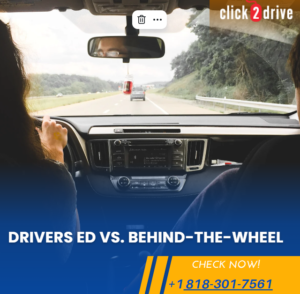Even the most skilled drivers can make a mistake while night driving on California roads. This emphasis on taking precautions for new and teenage drivers. According to a poll by the National Sleep Foundation, 60% of adults have driven while feeling tired, and 37% of adults, 103 million people have fallen asleep while driving.
This indicates that drivers of all ages need to drive slowly and carefully. In this blog, we will provide various tips to help you drive safely at night. We will also include various California law requirements that you must adhere to while nighttime driving.
We added various tips for new and teenage drivers in California to follow when they night driving, which they can learn from behind-the-wheel drivers training near them. First, let’s understand why night driving is so hard.
Night Driving Challenges in California
Night driving in California can be challenging for new drivers due to reduced visibility. It can be difficult to see pedestrians, road signs, and potential hazards due to the darkness, oncoming headlights, and bright streetlights that can create glare.
Distracted driving is also more common at night, as some drivers may be under the influence, texting on their phones, or feeling drowsy. Fatigue is another common issue at night, particularly for drivers who have been working long hours. Wildlife, such as deer, can also pose a serious threat, especially on unlit roads.
Night Driving Safety Tips in California
Here are some tips that can help new and experienced drivers prepare for nighttime driving in California. We have provided two sections: things to do before you start driving and tips to consider while night driving.
Before You Start Night Driving
1. Get a Good Night’s Sleep
Make sure to get a good night’s sleep before starting your driving. This is one of the necessary requirements if you want to drive safely at night, as drowsiness is one of the main reasons behind accidents at night. When you are refreshed, you can focus on your driving better. This is one of the few lessons they teach at driving school.
2. Ensure Proper Lighting
Make sure your car has good lighting to help you see while night driving. Check that your headlights, taillights, and brake lights are working properly. If your lights are not working well, it will not only be hard for you to see, but it will also make it hard for other drivers to see you, which could be dangerous.
3. Optimize Headlight Adjustment
Different headlights may need to be adjusted differently, so you should optimize yours to give the best visibility without blinding drivers coming towards you. If you’re not sure how to adjust your headlights, you can check your car’s manual or ask a mechanic for help.
4. Clean Windshield and Mirrors
Do you struggle with seeing clearly while night driving? A dirty windshield and mirrors can make it even more difficult. Clean them thoroughly with a glass cleaner to get rid of streaks, smudges, and dust. This will improve your visibility and reduce the glare from headlights and other lights.
5. Consider Anti-Reflective Glasses
If you wear glasses, you can also opt for anti-reflective glasses to further reduce glare from oncoming headlights and streetlights. This can help you see more clearly and reduce eye strain during your drive.
Things to Remember at Night While Driving
- Use low-beam headlights in most situations (switch to high beams only on open roads when safe and oncoming traffic is not present).
- Increase the following distance to allow more reaction time in case of hazards you might not see until the last minute due to reduced visibility.
- To maintain lane positioning, avoid looking directly into oncoming headlights. Instead, look down slightly to the right edge of the road.
- Put your phone away, silence notifications, and avoid eating or adjusting the radio while driving to minimize distractions inside the car.
- Be aware of pedestrians, cyclists, and animals, especially near unlit roads, as they may be harder to see in the darkness.
- Use your mirrors frequently to scan for approaching vehicles, merging cars, and motorcycles that might be less visible at night.
- Adjust the brightness of your dashboard lights to reduce glare that can interfere with your vision and ability to see the road ahead.
- If you feel tired at any point during your drive, pull over to a well-lit, safe location and take a break before continuing.
Additional Consideration for Nighttime Driving in California
California’s Basic Speed Law
Speed limit signs are just suggestions, not rules. The Basic Speed Law of California (Vehicle Code 22350) requires drivers to go at a “reasonable and careful” pace considering weather, visibility, and traffic conditions. At night, visibility is often reduced, which means you may need to drive slower than the posted speed limit, even if it’s 55 mph, due to factors such as heavy fog or poor lighting. Going too fast is a major cause of nighttime accidents.
California Hands-Free Law
Driving while being distracted is a serious danger, especially during the night when quick reactions are necessary. To ensure driving safety, California’s Hands-Free Law forbids drivers from using handheld electronic devices while driving. This includes activities such as texting, talking on the phone without a hands-free option, or using navigation apps that require constant interaction. Even the slightest diversion from the road to check your phone can have disastrous consequences, particularly in low-light conditions.
Nighttime Driving Tips for New and Teenage driver in California
While driving during the night may be easier for adults and experienced drivers, don’t forget that many drivers are learning. This is especially true for teenage drivers in California, who need to complete 10 hours of mandatory driving lessons to pass the exam. Here are some tips for first-time and new drivers to help them drive during the night.
Understanding Lane Positioning
Make sure to stay in the appropriate lane during night driving. It’s hard to follow the line, and if you make an unnecessary lane change, it could be harmful. Maintain safe following distance in high-speed traffic in California.
Hazard Perception
Make sure to scan the road ahead and anticipate potential hazards, such as merging vehicles or stopping traffic. This will help you react calmly to unexpected situations.
Blind Spot Awareness
One of the biggest issues during nighttime driving in California is blindspot on the road. Make sure to check your mirror and make the changes in the multilane freeway. Some of the driving schools in California teach about freeway and canyon driving, which can help during the night.
Cornering Techniques
Canyons are the hardest challenge for new drivers as they often have sharp turns. Follow safe cornering techniques, such as maintaining proper speed, using the correct lane position, and avoiding sudden braking or acceleration while navigating curves.
Conclusion
Even though we only drive 25% of the time at night, 50% of road fatalities occur during this time. That is why it is paramount to stay alert and drive carefully at night. While we take weather and other natural hazards at night while driving, we can never know about other people. That is why defensive driving and other driving techniques are useful for teenagers and new drivers in California. In this blog, we have provided tips on how to drive at night with ease. With these tips, it can help everyone reach their destination without any incidents.
Click2Drive is a leading driving school in Los Angeles with years of proven experience. We have provided instruction to thousands of students and teenage drivers in California. We offer a wide range of driving courses which can teach them how to drive carefully and make sure to keep an eye on their surrounding. If you are a teenager and want to learn how to drive and get your license in California, book an appointment today.




